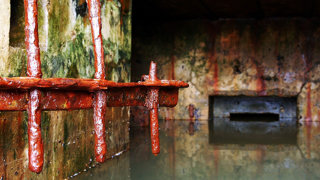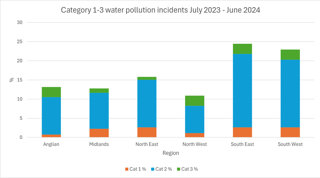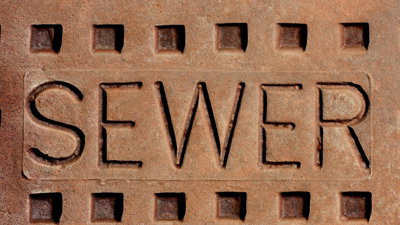Introduction
Sewage – wastewater from homes and businesses containing everything from dirty water to faecal matter, typically transported to treatment plants through a network of pipes and tunnels - made the news recently. Reports of increased category 1-3 pollution incidents, E. coli contamination, beach closures and the postponement of sporting events has drawn attention to the issue.

Since the earliest human settlements, it was evident that civilisations saw the importance of access to fresh water as well as removing waste from their settlement. Although people did not know the precise details about pathogens in untreated waste being the cause of disease, they did realise that using water sources such as rivers to remove waste and provide fresh water was important for health reasons. The earliest recorded sewage systems can be dated back to the Mesopotamians – a civilisation which grew along the Tigris and Euphrates rivers in present day Iraq, Syria, Turkey and Iran. Clay pipes have been found in this location and are thought to have been introduced around 4000BCE to remove human waste and collect fresh water.
History and causes
When populations were ‘low’ in comparison to today, disposing of human and animal waste was relatively simple. Sewage caused little to no impacts on people or the environment as it was thrown into rivers, buried, or used for fertiliser, However, as populations grew, particularly in urban areas, the proximity of waste to human settlements led to frequent outbreaks of diseases such as cholera. Therefore, there needed to be a different approach to managing waste.
The 19th century saw a change in sewage infrastructure in cities such as London in response to growing concerns over public health. Waste of all kinds, including rainwater, was directed through a network of sewers to treatment plants, where solids were treated before being dumped into waterways. As a result of this intervention, cases of waterborne disease were vastly reduced.
While much of this 19th century infrastructure remains today, it was never intended to handle the demands of modern populations. As a result, the system is under significant strain, with potentially large amounts of sewage leaking through aging or broken pipes into water systems.

Since the 1960s sewage systems in the UK have been upgraded to include separate pipes for sewage and stormwater. Major infrastructure upgrades such as the Thames Tideway Tunnel, known as a ‘super sewer’ have also gone a long way to alleviating pressure on the system. However, with over 100,000km of combined sewer systems—where wastewater and rainwater share the same pipes—during heavy rainfall, water companies can legally discharge sewage into open water to prevent the system from backing up and flooding homes. Although the additional water in the system helps to dilute it, there is still raw sewage being released into our waterways.
A joint investigation by the Environment Agency and Ofwat revealed that many water companies in England and Wales are failing to manage their wastewater treatment plants properly and therefore releasing harmful, untreated waste into open water, potentially in violation of the law. These illegal discharges, known as 'dry spills,' occur when sewage is released without the risk of flooding during periods of little or no rainfall. Without rainwater to dilute the sewage, these spills release highly concentrated waste, posing serious risks to public health and the environment. An investigation by the BBC revealed that as many as 6000 dry spills were conducted by water companies in 2022. Such incidents are particularly dangerous during fair weather, when people are more likely to be swimming or cooling off in open water.
Effects

Between July 2023 and June 2024, the Environment Agency reported 266 category 1-3 water pollution incidents. Category 1 incidents are the most severe level and signify serious, extensive or persistent impacts on the environment, people or property. Category 2 incidents have lesser but still significant impacts and Category 3 incidents have minor to minimal impacts. Although the number of Category 1 incidents is still relatively low, the number of Category 2 incidents remains high across all the regions of England. Devon and Somerset experienced the highest, with 7% and 5% of all incidents reported during this period.
A total of 3.6 million hours of raw sewage was discharged into open water in 2023 in England and Wales, double that of 2022.
Untreated sewage and storm overflow water can contain various contaminants including bacteria, chemicals, heavy metals, fertilisers, pesticides, and even recreational drugs, all of which can have serious consequences for both people and the environment.
The impact on the aquatic life near the spills can be vast; for example, a blocked sewer was responsible for the death of hundreds of small fish, eels and insects in a 1.7km stretch of the Dinmore Brook in Gloucestershire. Within this stretch of water, a thick layer of algae was found, called sewage fungus, which reduces oxygen levels in the water killing river species.
One type of harmful bacteria that can be found in sewage is E. coli. If ingested, it can lead to stomach cramps, fever, diarrhoea, and even vomiting. High levels of E. coli were responsible for the postponing of the Olympic Triathlon in Paris after rainwater took levels in the Seine to above safe levels. Additionally, numerous open water events have been cancelled this summer due to similarly high bacteria levels, including Lyme Splash, an annual charity swim from Lyme Regis to Charmouth, and the sea swim leg of the 1066 triathlon in East Sussex.

Sewage spills have also impacted the local economy. For instance, no-swim warnings issued in Exmouth led to a drop in beach visitors, reducing foot traffic during the peak summer season. As a result, local businesses are considering legal action to ensure sewage levels are better managed and kept to a minimum.
Responses and futures
In response to the increased water pollution generated by raw sewage, the government intends to pass a Water Bill that will impose harsher penalties to water companies and their executives who are found to be illegally polluting waterways. This bill has come under criticism from some campaigners as they feel that, as these practices happen already, the real issue lies more within regulators failing to enforce existing laws.
In addition, many water companies have pledged to invest in repairing and updating sewers to help reduce the amount of sewage spills. For example, United Utilities – a water company for the northeast of England, has pledged to spend an additional £156m on top of an earlier pledge of £41m to upgrade nine wastewater treatment works and six storm overflows to cut sewage spills in Lake Windermere by 75% by 2028.
Ofwat, the water regulation authority for England and Wales, has announced an investment of £10bn to address storm overflows, aiming to reduce spills from this source by 44% in comparison to 2021 levels. This is part of a £88bn plan to improve water quality and help mitigate the effects of climate change[2]. While initial funding will come from water companies and borrowing, repayments will be covered by gradually increasing water bills for consumers over a five-year period, putting more pressure on household finances.
While investment in infrastructure is welcomed, there are growing calls for more sustainable approaches to manage sewage in the UK. One possible solution from the Environment Agency[3] could be to use sludge – the solid waste left over from treated wastewater – as a source of organic manure in agriculture. On a local level, the use of composting toilets and untreated water for irrigation and toilet flushing would reduce the reliance on fresh water sources enabling treated water to be used more sustainably.
Further reading
